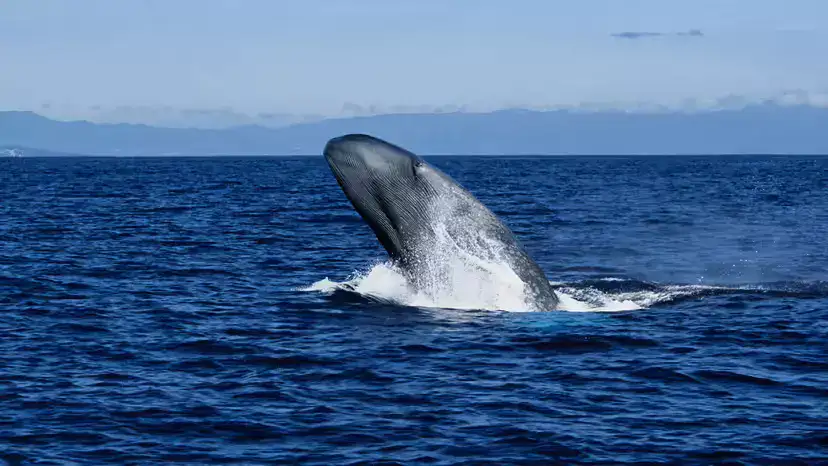World’s biggest animal: Up to ~110 ft (33.5 m) and ~330,000 lb (150 t).
Filter-feeder: Specializes in krill, using baleen plates and expandable throat pleats to engulf prey-rich water.
Long-lived & far-ranging: Typically 80–90 years (recorded ~110), migrating thousands of miles each year.
Loud communicators: Among the loudest animals on Earth; very low-frequency calls can travel hundreds of miles.
Main risks today: Fishing-gear entanglement, ship strikes, noise and chemical pollution, and climate-driven prey shifts.

What Is a Blue Whale?
Anatomy & Superlatives
Diet & Feeding Strategy
Life Cycle & Behavior
Range, Populations & Where to See Them
Sound & Communication
Conservation Status, Threats & What Works
Quick FAQs
Blue whales are rorqual baleen whales—a group defined by long throat grooves (ventral pleats) that let the mouth balloon during “lunge-feeding.” Though their backs often look slate-gray at the surface, subsurface light makes them appear blue, giving the species its name.
Length / mass: Commonly 70–90 ft (21–27 m); exceptional individuals approach ~110 ft (33.5 m).
Baleen: ~270–395 flexible keratin plates per side act as a living sieve for krill.
Throat pleats: 50–100+ grooves enable a single gulp of water weighing several tons.
Circulatory feats: A heart roughly the size of a small motorcycle pumps oxygen through a body built for marathon dives.
Calves: Among the largest babies on Earth—~20–26 ft (6–8 m) at birth, ~5,000–8,000 lb (2–3.6 t), drinking tens of gallons of energy-rich milk daily and gaining ~150–200 lb (70–90 kg) per day in the first months.
Target: Krill swarms.
Technique: Lunge feeding—accelerate → engulf prey-dense water → close mouth → tongue presses water through baleen → swallow trapped krill.
Daily intake (peak season): Often several tons of krill per day.
Why it works: Blue whales time migrations to seasonal krill blooms at high latitudes, then fast or feed lightly on migration/breeding grounds.
Longevity: Commonly 80–90 years; some older.
Maturity: ~5–15 years; single calf after a ~11–12 month gestation.
Sociality: Usually solo, pairs, or loose groups at rich feeding fronts.
Migration: Broad pattern of polar feeding (summer) → warmer breeding regions (winter); routes differ by ocean basin.
Dive profile: Foraging dives commonly 10–20 minutes; shallow travel dives between lunges.
Blue whales occur in all oceans except the Arctic, with several recognized subspecies or regional populations:
Antarctic blue whale (B. m. intermedia): The largest form; summers in the Southern Ocean near the ice edge.
Pygmy blue whale (B. m. brevicauda): Smaller, widespread in the Indian Ocean and southern Indo-Pacific (Australia–Indonesia–Madagascar–New Zealand corridors).
Northern blue whale (B. m. musculus): North Pacific and North Atlantic populations with feeding grounds off the U.S. West Coast, North Atlantic fronts, and high-latitude shelves.
Northern Indian Ocean blue whale (B. m. indica): Around Sri Lanka, India, Maldives, Somalia; some may be less migratory.
Chilean (Southeast Pacific) population: Uses Patagonian and southeast Pacific habitats (taxonomy still being refined).
California, USA: Channel Islands & Monterey Bay (summer–fall feeding).
Baja California Sur, Mexico: Loreto Marine Reserve (winter–spring).
Azores, Portugal: Spring migrations.
Saguenay–St. Lawrence, Canada: Productive summer feeding fronts.
Mirissa, Sri Lanka: Year-round sightings peak with monsoon-driven productivity.
Skjálfandi Bay, Iceland: Summer.
Tip: Respect local guidelines: stay slow (≤10 kn in whale zones), keep distance buffers, and avoid sudden course changes.
Among the loudest animals: Calls can exceed 180 dB re 1 µPa @1 m (low frequency).
Why low frequency matters: Long wavelengths travel farther in seawater; blue whales likely use calls for mate location, spacing, and contact across vast, often turbid seas.
Noise threats: Chronic shipping noise can mask these calls, potentially affecting mating and foraging efficiency.
Status: Endangered on the IUCN Red List. Global numbers are in the low tens of thousands at most, far below pre-whaling levels. International commercial whaling has been banned for blue whales since the 1960s, aiding partial recovery in some regions.
Vessel strikes: Fast ships on migration/feeding corridors.
Fishing-gear entanglement: Particularly in fixed gear with vertical lines.
Noise pollution: Masks communication and can alter behavior.
Chemical pollutants & plastics: Bioaccumulation risks and debris ingestion.
Climate change: Alters krill distribution and bloom timing, potentially decoupling whale migrations from prey peaks.
Slow-speed zones & dynamic routing where whales aggregate.
Gear innovation: Weak-link lines, on-demand (ropeless) gear trials to reduce entanglements.
Noise-smart shipping: Re-routing, speed reductions, propeller/engine quieting tech, port incentive programs.
Protected areas & real-time alerts: Seasonal management around feeding fronts.
Long-term monitoring: Acoustics, photo-ID, tags, and krill/sea-ice surveys to adapt management to changing oceans.
How do blue whales communicate so far away?
They produce very low-frequency, high-intensity calls that propagate over hundreds of miles under water, enabling contact across oceanic scales.
What do blue whales eat and how much?
Primarily krill. During peak feeding they may consume several tons per day, fueled by dense krill swarms in productive polar waters.
Who hunts blue whales?
Killer whales (orcas) occasionally attack blue whales—even calves and juveniles—despite being much smaller. Such interactions may become more visible as both predators and great whales recover in some regions.
Where can I responsibly see them?
Coasts of California, Baja, the Azores, Sri Lanka, Quebec’s St. Lawrence, and Iceland are reliable—season dependent. Choose operators that follow certified wildlife-safe guidelines.
animal tags: blue whale
We created this article in conjunction with AI technology, then made sure it was fact-checked and edited by a Animals Top editor.